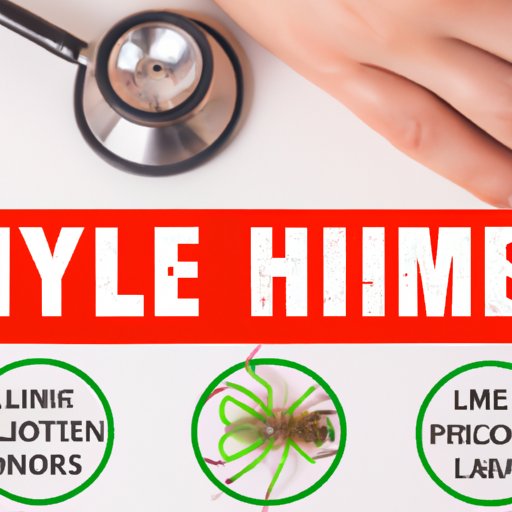
I. Introduction
Lyme disease is an infectious illness caused by the bacterium Borrelia burgdorferi that is transmitted through the bite of an infected tick. In recent years, the number of Lyme disease cases has been rising steadily in many parts of the world. It’s important to know the symptoms and risk factors associated with the disease, as early detection and treatment can help prevent long-term complications.
II. Symptoms to Look Out For
The most recognizable symptom of Lyme disease is a bulls-eye rash that appears within a few weeks of being bitten by an infected tick. Other early symptoms include fever, headache, fatigue, and muscle and joint pain. If left untreated, Lyme disease can cause serious neurological, cardiac, and joint problems. Seeking immediate medical attention is essential if experiencing any of these symptoms.
Early detection and treatment can make a significant difference in the outcome of a Lyme disease infection. According to the Centers for Disease Control and Prevention, patients who receive prompt antibiotic treatment in the early stages of infection usually recover rapidly and fully.
III. Geographic Risk Factors
Lyme disease is especially prevalent in the northeastern and mid-Atlantic states of the US, as well as in some parts of Europe and Asia. In these areas, the number of cases can reach much higher levels during the summer and spring months when ticks are most active.
If you are in or near wooded areas where infected ticks are present during the peak season, it is important to take precautions like wearing long sleeves and pants, using insect repellent with DEET, and doing frequent tick checks. After any time spent in a wooded area, check for ticks on your body, paying particular attention to your neck, scalp, and groin area. If you find a tick that is still attached, use a pair of tweezers to remove it immediately, grasping the tick’s head as close to your skin as possible.
IV. Prevention Tips
The best way to prevent Lyme disease is to avoid exposure to the ticks that transmit it. This can be achieved through using protective clothing like long pants, socks, and boots in wooded areas, using insect repellent with DEET, and minimizing tick habitats around your home and property. This can be done by keeping your lawn mowed and free from leaf litter, woodpiles, and tall brush.
When using insect repellent, follow all instructions carefully, and avoid applying it directly to your skin or near your eyes or mucous membranes. If you have pets that spend time outdoors, make sure to check them regularly for ticks and apply tick-prevention medication as recommended by your veterinarian.
V. Testing and Diagnosis
Testing for Lyme disease is typically performed when a patient experiences symptoms of the disease, such as rash, fever, and muscle or joint pain, and has a recent history of tick exposure. Doctors test for Lyme disease using a blood test. Two-tier testing using ELISA and Western blot tests can help confirm the diagnosis.
In some cases, initial tests may not be sensitive enough to detect the infection, and additional tests may be necessary. If you receive a negative test result, but your symptoms persist, you may need to undergo further diagnostic tests to determine the cause of your symptoms.
VI. Treatment Options
Most people with Lyme disease are treated with oral antibiotics like doxycycline, amoxicillin, or cefuroxime for two to four weeks. In more severe cases, intravenous antibiotics may be needed. Patients who receive prompt antibiotic treatment in the early stages of infection usually recover rapidly and fully, although a small percentage of patients may experience symptoms for months.
Some people choose to use herbal remedies and natural supplements to support their immune system and alleviate symptoms during and after treatment. However, patients should always consult their doctor before starting any alternative treatments or supplements to avoid any adverse interactions with medications or health problems.
VII. Conclusion
Knowing the risk factors, symptoms, and preventive measures associated with Lyme disease can help you stay safe and healthy. It’s important to seek immediate medical attention if experiencing any symptoms. By taking preventive measures like wearing protective clothing, using insect repellent, and checking for ticks, you can significantly reduce your risk of contracting Lyme disease. Your doctor can help you navigate testing options and treatment plans if necessary.




